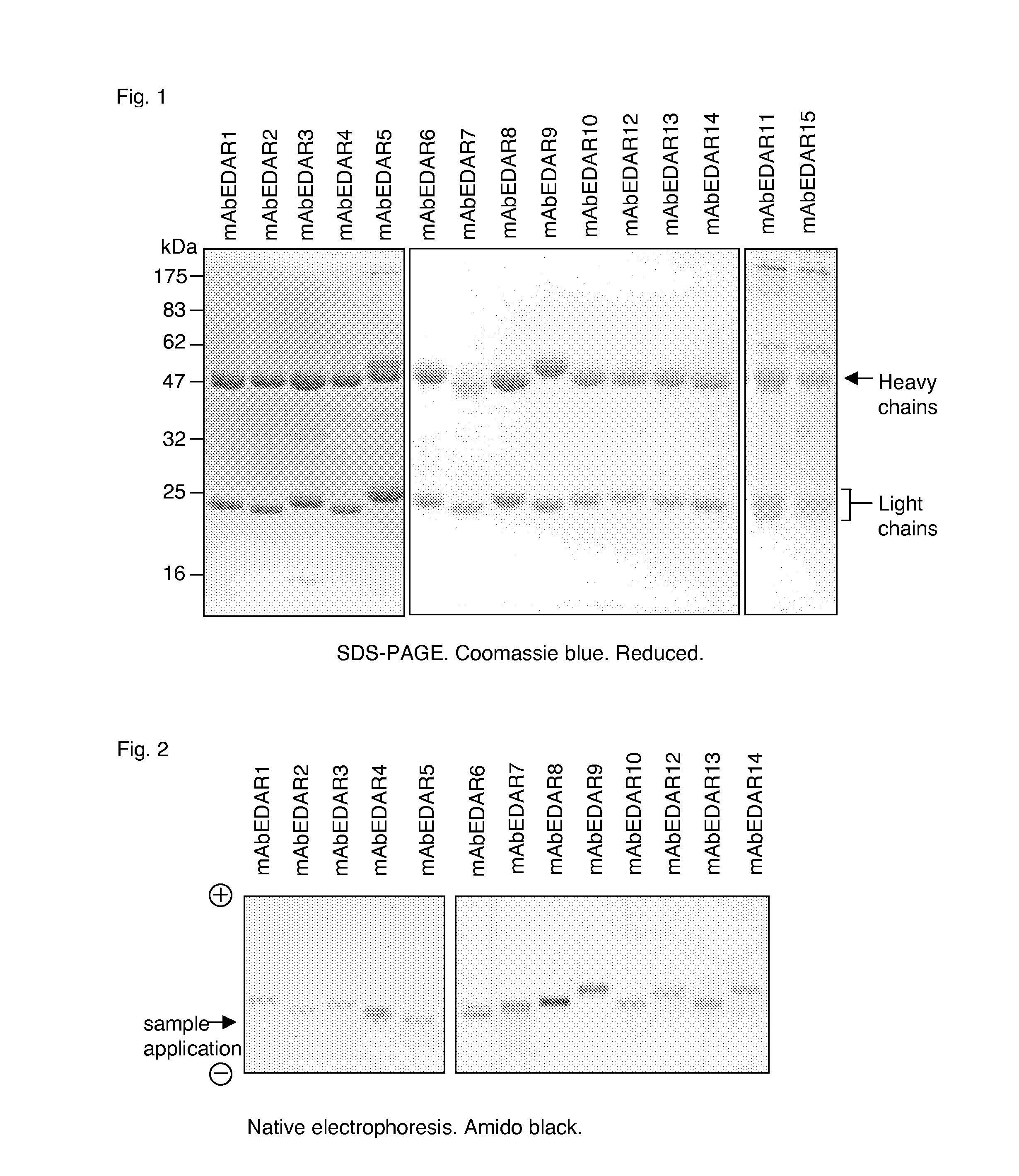Preparation of isolated agonist anti-EDAR monoclonal antibodies
a monoclonal antibody and agonist technology, applied in the field of preparation of substantially purified agonist antiedar monoclonal antibodies, can solve the problems of hair shaft abnormalities, hair bulb aberration, bifid, small, etc., and achieve the effect of increasing the development of one or more hair follicles
- Summary
- Abstract
- Description
- Claims
- Application Information
AI Technical Summary
Benefits of technology
Problems solved by technology
Method used
Image
Examples
example 1
Anti-EDAR Monoclonal Antibodies, Development, Identification and Characterization
Preparation of Soluble EDAR
[0382]Development of the EDAR-Fc expression vector. The EDAR-Fc gene construct was cloned into the PCR3 mammalian expression vector (Invitrogen) according to standard molecular biology techniques. Development of the vector for expression of EDAR-Fc has been described previously (Holler, N., Tardivel, A., Kovacsovics-Bankowski, M., Hertig, S., Gaide, O., Martinon, F., Tinel, A., Deperthes, D., Calderara, S., Schulthess, T., Engel, J., Schneider, P., and Tschopp, J. 2003 Mol Cell Biol 23, 1428-1440; Bossen, C., Ingold, K., Tardivel, A., Bodmer, J. L., Gaide, O., Hertig, S., Ambrose, C., Tschopp, J., and Schneider, P. 2006 J Biol Chem 281, 13964-13971; Schneider, P. 2000 Meth. Enzymol. 322, 322-345; Holler, N., Kataoka, T., Bodmer, J. L., Romero, P., Romero, J., Deperthes, D., Engel, J., Tschopp, J., and Schneider, P. 2000 J Immunol Methods 237, 159-173).
[0383]Development of stab...
example 2
Binding of mAbEDAR1, 2, 3, 4, 5, 6, 7, 8, 9, 10, 11, 12, 13, 14 and 15 Monoclonal Antibodies to Both Human and Mouse EDAR (FIGS. 6, 9)
[0396]Immunization of mice with human antigens usually gives rise to antibodies that do not cross-react with the mouse homologous proteins. In order to obtain antibodies recognizing both human and mouse EDAR, a feature which would considerably facilitate pre-clinical development of drug candidates, EDAR-deficient mice were immunized with human EDAR. It was then assessed whether monoclonal antibodies generated from these mice indeed recognized EDAR from these two animal species. The wells of microtiter plates were coated with soluble human and mouse EDAR-Fc fusion protein and a negative control protein (human Fas-Fc), blocked and probed with serial dilutions of anti-EDAR monoclonal antibody (mAb) mAbEDAR1, 2, 3 and 4 and a negative control mAb (Aprily 5) (FIG. 6), or with a single dose of mAbEDAR1 to 15 (FIG. 9). The presence of bound antibodies was re...
example 3
Mapping of the Region on EDAR Recognized by the Anti-EDAR mAb (FIGS. 9, 10 and 11)
[0398]EDAR is a transmembrane protein whose extracellular part is composed of three membrane distal cystein-rich domains (CRDs) and of a proximal membrane stalk domain (FIG. 9A). Constructs coding for the entire EDAR protein, domains I and II, domains II and III, domain III and the stalk domain, domains I, II and III alone and the stalk domain alone were assembled with the Fc region of human IgG1, inserted into a mammalian expression vector and transiently transfected in 293T cells. Culture supernatants were captured in an ELISA plate with an anti-human IgG antibody, and revealed using the anti-EDAR mAb mAbEDAR1 to 15 and a horseradish peroxydase-coupled anti-human IgG mAb to monitor that the various EDAR-Fc truncation mutants had been efficiently captured. mAbEDAR1, 2, 3, 4, 7, 8, 10 and 11 recognize the fragment made up of domains I and II. The other fragments were not recognized, in particular the f...
PUM
| Property | Measurement | Unit |
|---|---|---|
| concentrations | aaaaa | aaaaa |
| concentration | aaaaa | aaaaa |
| concentration | aaaaa | aaaaa |
Abstract
Description
Claims
Application Information
 Login to View More
Login to View More - R&D
- Intellectual Property
- Life Sciences
- Materials
- Tech Scout
- Unparalleled Data Quality
- Higher Quality Content
- 60% Fewer Hallucinations
Browse by: Latest US Patents, China's latest patents, Technical Efficacy Thesaurus, Application Domain, Technology Topic, Popular Technical Reports.
© 2025 PatSnap. All rights reserved.Legal|Privacy policy|Modern Slavery Act Transparency Statement|Sitemap|About US| Contact US: help@patsnap.com



